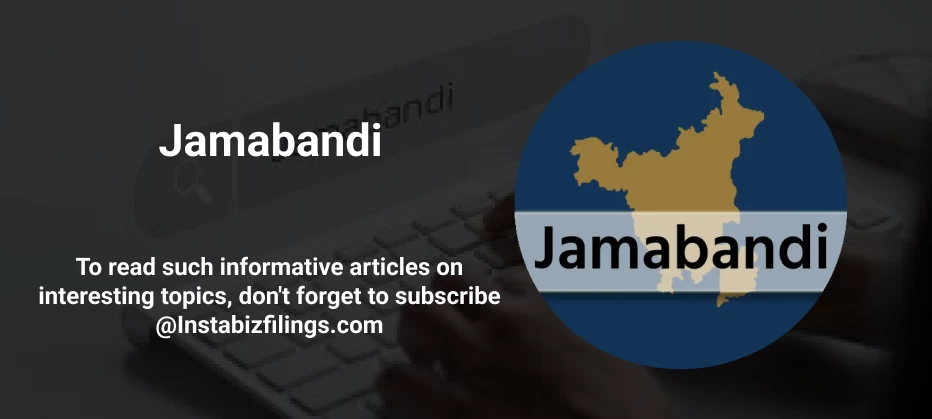
Jamabandi
August 15, 2025 by Team Instabizfilings
Introduction to Jamabandi
Jamabandi is an ancient revenue registration in India, it is mostly found in the states of Punjab, Haryana, Rajasthan, Bihar, Assam, and Himachal Pradesh. SA- land record document is an official document by which information on ownership, cultivation and land usage rights of a given piece of land is made available in detail. A land record document, in simple terms, is a property and is mostly used to establish ownership of the land.
Key Components of Jamabandi
-
Land Owner Information: Name of the land owner (s) and the percentage in the land that he or she possesses.
-
Details of the Land: Type of land (agriculture, commercial, residential and so on), area and boundary of the land.
-
Khasra Number: It is a land-based identification number.
-
Revenue Details: Details of revenue assessments of the land, like land tax and payment status of the land.
-
Land Usage: Is there any form of land usage (agriculture process, construction, etc.).
-
Possession Details: Details relating to whom or what body the land is possessed by (e.g., lord in the case of land that is not possessed by somebody (owned).
-
Mutation Record: Whether there is a change in the title or any other information of the land.
Jamabandi Across Different States
- Jamabandi in Bihar: They mostly use Jamabandi records in Bihar to assure ownership, farm produce and tax outcomes. The state of Bihar has computerised such records to have them in the form of the internet.
- Jamabandi in Assam: Assam Jamabandi has been referred to as Dharitri Jamabandi or the land record document. Important details about land possession are contained in this document, and it is easy to deal with land.
- Jamabandi in Haryana: Haryana also holds online records of Jamabandi, and that is Jamabandi Nakal Haryana. Citizens get an easy chance to get their Jamabandi records through the authorised Haryana land records portal.
- Jamabandi in Punjab: A thorough online Jamabandi process is available in Punjab, and commonly known as Fard Jamabandi. Through this system, we are able to see the land record of any property in the state.
- Jamabandi in Rajasthan: In Rajasthan, the Jamabandi records are available online via the Jamabandi Nakal Rajasthan system. The process is devoid of any hitch, and it assists in solving of land disputes in an efficient manner.
Online Jamabandi Systems
Amidst the growing extent of digitalisation, various states have introduced online Jamabandi interfaces to facilitate the work of accessing the land records by the citizens.
-
Haryana Jamabandi Online: Haryana citizens are allowed to see the Haryana land records on the official portal of the Haryana government online.
-
Bihar Jamabandi Online: In the state of Bihar, it is possible to access Jamabandi records online through the official land records portal; thus, the process of land verification becomes really accelerated.
-
Assam Jamabandi Online: Assam has also introduced a revenue Jamabandi system where land records can be checked online by residents.
-
Rajasthan Jamabandi Online: In Rajasthan, too the information of Jamabandi can be obtained on the Internet in order to check both property and ownership information.
How to Check Jamabandi Online
-
Visit the Official Portal: On the state level, there is a specific site. E.g. in Haryana, people can go and check the records at the address of www.jamabandi.nic.in.
-
Enter Details: Key in details, either the Khasra number, property number or any other detail that you may need, such as the name of the landowner.
-
Download the Document: After accessing the record, you can take down a copy of your Jamabandi or Nakal (copy of the record).
-
Mutation Process: In case you require updating and or mutating of the land record following a change of ownership, the portal will give you directions of the mutation process.
Jamabandi Nakal and Patta
-
Jamabandi Nakal: It is a trolling of the Jamabandi extract. Either it is in the office of the department of concern to the revenue or on the internet a Nakal Jamabandi.
-
Patta: The deed that makes you the owner of a certain parcel. Jambandi record will be the testimony of the right of land and Jamabandi Patta is the document that asserts the same.
Meaning and Importance of Jamabandi
- Proof of Ownership: It also acts as a legal evidence of land ownership which is used to dispel ownership wrangles.
- Revenue Collection: and this is what is used by the government to collect the land tax and revenue.
- Land Transaction: It is necessary in the case of buying, selling or taking (mortgaging) land.
- Dispute Resolution: It facilitates settling land-related disputes by ensuring they are well documented.
How to Obtain Jamabandi
-
Offline: Go to your nearest Tehsil office/ Revenue Department office and get the Jamabandi record of your land.
-
Online: In a number of states there is also the option of downloading the Jamabandi record off of government websites.
Conclusion
Jamabandi is a rather significant paper as far as land verification, holding land and revenue collection in India are concerned. As the world turns more and more digital, viewing Jamabandi records online has become even easier, which is beneficial not only to the land owners but also to the government. Whether in Punjab, whether in Bihar, whether in Assam, and Haryana, one will find learning the procedure of doing Jamabandi and how one can have the information of the same could make errands very easy which are related to land.
Disclaimer
The information provided in this blog is purely for general informational purposes only. While every effort has been made to ensure the accuracy, reliability and completeness of the content presented, we make no representations or warranties of any kind, express or implied, for the same.
We expressly disclaim any and all liability for any loss, damage or injury arising from or in connection with the use of or reliance on this information. This includes, but is not limited to, any direct, indirect, incidental, consequential or punitive damage.
Further, we reserve the right to make changes to the content at any time without prior notice. For specific advice tailored to your situation, we request you to get in touch with us.


